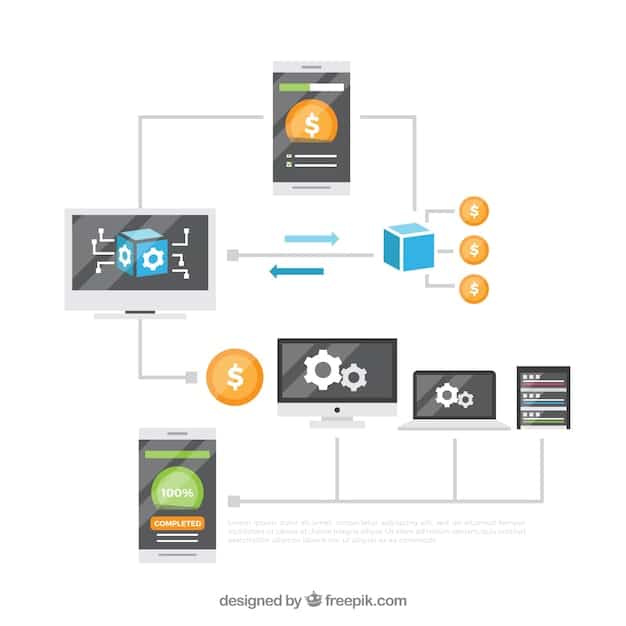The Ultimate Guide to Building a Scalable Tech Stack for Your Fintech Startup in 2025

The ultimate guide to building a scalable tech stack for your fintech startup in 2025 involves choosing the right technologies, architecture, and practices to ensure that your platform can handle growth, adapt to changing market demands, and remain secure and compliant.
Building a robust and scalable tech stack is crucial for any fintech startup aiming for significant growth. This article provides the ultimate guide to building a scalable tech stack for your fintech startup in 2025, ensuring long-term success and adaptability in a rapidly evolving market.
Why a Scalable Tech Stack Matters for Fintech Startups
In the fast-paced world of fintech, scalability is not just a buzzword; it’s a necessity. A scalable tech stack allows your startup to handle increasing transaction volumes, accommodate new features, and adapt to regulatory changes without significant disruptions. Without it, you risk being outpaced by more agile competitors.
A well-planned tech stack ensures that your infrastructure can efficiently support your business as it grows, preventing performance bottlenecks and maintaining a seamless user experience. It also enables faster deployment of new products and features, giving you a competitive edge.
Long-Term Cost Efficiency
Investing in a scalable architecture upfront can lead to significant cost savings in the long run. As your user base and transaction volume grow, a scalable system can handle the increased load without requiring constant hardware upgrades or extensive code refactoring.
Enhanced Agility and Adaptability
A scalable tech stack provides the agility needed to adapt to changing market conditions and customer demands. You can quickly integrate new technologies, experiment with innovative features, and respond to emerging opportunities without being limited by your infrastructure.

Consider these key benefits of scalability:
- Improved Performance: Handles increased traffic and data load without performance degradation.
- Reduced Downtime: Minimizes disruptions during upgrades and maintenance.
- Faster Time to Market: Enables quicker deployment of new features and products.
- Compliance Readiness: Simplifies adherence to regulatory requirements as your business expands.
In summary, a scalable tech stack is a strategic investment that pays dividends in terms of efficiency, agility, and long-term sustainability. It sets the foundation for a successful fintech startup capable of thriving in a competitive landscape.
Key Components of a Scalable Fintech Tech Stack
Building a scalable tech stack involves carefully selecting the right components and ensuring they work seamlessly together. This section outlines the key elements you should consider when designing your fintech infrastructure.
A well-structured tech stack encompasses several critical layers, from the user interface to the back-end systems that handle transactions and data management. Each component should be chosen with scalability, security, and compliance in mind.
Front-End Technologies
The front-end is the user interface, and it needs to be responsive, intuitive, and accessible. Modern JavaScript frameworks like React, Angular, and Vue.js are excellent choices for building dynamic and scalable user interfaces.
Back-End Technologies
The back-end handles the core logic of your application, including transaction processing, data storage, and API management. Languages like Python, Java, and Node.js are popular choices for building scalable and reliable back-end systems.

Here are essential components to consider:
- Databases: Choose databases that can handle large volumes of transactional data efficiently. Options include NoSQL databases like Cassandra and MongoDB, as well as scalable SQL databases like PostgreSQL with extensions.
- APIs: Design your APIs with scalability in mind, using RESTful or GraphQL architectures. Ensure that your APIs can handle a large number of requests and are well-documented for third-party integrations.
- Cloud Infrastructure: Leverage cloud platforms like AWS, Azure, or Google Cloud for scalable computing, storage, and networking resources. These platforms offer a wide range of services that can be tailored to your specific needs.
In essence, each component of your tech stack needs to be carefully selected and integrated to ensure scalability, security, and efficiency. By focusing on these key elements, you can build a robust infrastructure capable of supporting your fintech startup’s growth and innovation.
Choosing the Right Cloud Platform for Scalability
Selecting the right cloud platform is a pivotal decision when building a scalable tech stack for your fintech startup. Cloud platforms offer the infrastructure, services, and tools needed to support rapid growth and innovation. Amazon Web Services (AWS), Microsoft Azure, and Google Cloud Platform (GCP) are the leading contenders, each with its unique strengths.
The right cloud platform can provide the scalability, reliability, and security required for a fintech environment. It allows you to easily scale resources up or down based on demand, ensuring optimal performance and cost efficiency.
Amazon Web Services (AWS)
AWS is the most mature and widely adopted cloud platform, offering a comprehensive suite of services for computing, storage, databases, and analytics. It’s known for its extensive ecosystem, robust security features, and global reach.
Microsoft Azure
Azure is a strong choice for startups that rely heavily on Microsoft technologies. It offers seamless integration with Windows Server, .NET, and other Microsoft products, along with advanced AI and machine learning capabilities.
Google Cloud Platform (GCP)
GCP is renowned for its expertise in data analytics, machine learning, and Kubernetes. It offers innovative solutions for big data processing and is a great option for startups focused on data-driven insights.
Consider the following factors when choosing a cloud platform:
- Scalability Features: Evaluate the platform’s auto-scaling capabilities, load balancing options, and database scalability.
- Security and Compliance: Ensure the platform meets the security and compliance requirements specific to the fintech industry.
- Cost Structure: Understand the pricing models for different services and choose a platform that aligns with your budget and growth projections.
- Integration Capabilities: Verify that the platform integrates well with your existing technologies and third-party services.
In conclusion, selecting the right cloud platform is a strategic decision that impacts your fintech startup’s scalability, security, and cost efficiency. By carefully evaluating your options and considering your specific needs, you can choose a platform that empowers your business to thrive.
Database Solutions for Scalable Fintech Applications
Choosing the right database solution is essential for building scalable fintech applications. Databases are the backbone of any fintech system, storing and managing critical financial data. Scalability, reliability, and security are paramount when selecting a database for your startup.
Choosing the appropriate database requires careful consideration of your application’s specific needs and future growth plans. Scalable databases ensure that your system can handle increasing data volumes and transaction loads without performance degradation.
SQL vs. NoSQL Databases
SQL databases like PostgreSQL and MySQL offer strong data consistency and support complex transactions, making them suitable for applications requiring strict data integrity. NoSQL databases like Cassandra and MongoDB provide greater scalability and flexibility, ideal for handling large volumes of unstructured or semi-structured data.
Cloud-Native Database Services
Cloud platforms offer managed database services like Amazon RDS, Azure SQL Database, and Google Cloud SQL, which simplify database management and provide built-in scalability and high availability. These services can automatically scale resources based on demand, reducing the operational overhead for your team.
Database Sharding and Partitioning
Database sharding and partitioning are techniques used to distribute data across multiple servers, improving performance and scalability. Sharding involves splitting the database into smaller, more manageable pieces, while partitioning divides a single table into multiple parts.
Key considerations when selecting a database solution include:
- Data Volume and Velocity: Choose a database that can handle your current and projected data volume and transaction velocity.
- Data Consistency Requirements: Determine the level of data consistency required by your application and choose a database that meets those requirements.
- Scalability Needs: Select a database that can scale horizontally to accommodate future growth.
- Security Features: Ensure the database offers robust security features to protect sensitive financial data.
Ultimately, selecting the right database solution is critical for building a scalable, reliable, and secure fintech application. By carefully evaluating your options and considering your specific requirements, you can choose a database that supports your startup’s growth and innovation.
API Design and Management for Fintech Scalability
Effective API design and management are crucial for achieving scalability in fintech applications. APIs (Application Programming Interfaces) enable different components of your system to communicate with each other, as well as facilitating integrations with third-party services and partners.
Well-designed APIs ensure that your system can handle a large number of requests efficiently and securely. They also enable faster development and deployment of new features and integrations.
RESTful vs. GraphQL APIs
RESTful APIs are a widely adopted standard for building web services, offering a simple and scalable architecture based on HTTP methods like GET, POST, PUT, and DELETE. GraphQL APIs provide greater flexibility by allowing clients to request only the data they need, reducing over-fetching and improving performance.
API Gateways
API gateways act as a central point of entry for all API requests, providing features like authentication, authorization, rate limiting, and request routing. They help to manage and secure your APIs, as well as improve their performance and scalability.
API Documentation and Versioning
Clear and comprehensive API documentation is essential for developers who need to integrate with your system. API versioning allows you to make changes to your APIs without breaking existing integrations, ensuring backward compatibility.
Key aspects of API design and management include:
- Scalability: Design your APIs to handle a large number of concurrent requests without performance degradation.
- Security: Implement robust authentication and authorization mechanisms to protect your APIs from unauthorized access.
- Performance: Optimize your APIs for speed and efficiency, using caching and compression techniques.
- Manageability: Use API gateways and management tools to monitor and control your APIs.
In conclusion, effective API design and management are vital for building a scalable and interoperable fintech ecosystem. By following best practices and using the right tools, you can ensure that your APIs support your startup’s growth and innovation.
Ensuring Security and Compliance in Your Tech Stack
Security and compliance are non-negotiable aspects of any fintech tech stack. Fintech startups handle sensitive financial data and must adhere to strict regulatory requirements to protect their customers and maintain their trust. Building a secure and compliant tech stack from the outset is crucial for long-term success.
A robust security posture safeguards your business from cyber threats and data breaches, preventing financial losses and reputational damage. Compliance with industry regulations ensures that you operate within the bounds of the law and maintain the confidence of regulators and customers.
Data Encryption
Data encryption is a fundamental security measure that protects sensitive data both in transit and at rest. Use strong encryption algorithms like AES-256 and TLS 1.2 or higher to encrypt data when it is transmitted over networks and stored in databases.
Access Controls and Authentication
Implement strict access controls and authentication mechanisms to ensure that only authorized users can access sensitive data and systems. Use multi-factor authentication (MFA) to add an extra layer of security, and regularly review and update access permissions.
Compliance Standards
Fintech startups must comply with various regulatory standards, depending on their location and the services they offer. These may include PCI DSS for payment card data, GDPR for data privacy, and KYC/AML regulations for anti-money laundering.
Key steps to ensure security and compliance include:
- Conducting regular security assessments and penetration testing.
- Implementing a robust incident response plan.
- Staying up-to-date with the latest security threats and compliance requirements.
- Training employees on security best practices.
In summary, ensuring security and compliance is an ongoing process that requires a proactive approach. By prioritizing security and adhering to regulatory standards, you can build a trusted and resilient fintech startup capable of thriving in a challenging environment.
| Key Point | Brief Description |
|---|---|
| 💡 Scalability Importance | Ensures your fintech startup can handle growth and adapt to market changes. |
| ☁️ Cloud Platform Selection | Choosing the right cloud platform (AWS, Azure, GCP) is crucial for resource scalability. |
| 🔒 Security & Compliance | Prioritizing data encryption and compliance standards protects sensitive information. |
| ⚙️ Database Solutions | Selecting a scalable database (SQL or NoSQL) supports efficient data management. |
Frequently Asked Questions (FAQ)
▼
A scalable tech stack refers to the collection of technologies, tools, and infrastructure that enable a fintech startup to handle growth and adapt to changing market conditions. It is essential for ensuring performance, reliability, and cost-efficiency as the business expands.
▼
Amazon Web Services (AWS), Microsoft Azure, and Google Cloud Platform (GCP) are all excellent choices for building scalable fintech applications. The best option depends on your specific requirements, existing infrastructure, and long-term growth plans.
▼
To ensure security, implement data encryption, strict access controls, multi-factor authentication, and regular security assessments. Staying compliant with industry regulations and training employees on security best practices are also crucial steps.
▼
Key considerations include data volume, velocity, consistency requirements, scalability needs, and security features. Choosing between SQL and NoSQL databases depends on the specific needs of your application and the type of data you’re handling.
▼
API design is crucial for scalability. Well-designed APIs enable different components of your system to communicate efficiently and facilitate integrations with third-party services. Using API gateways ensures security, performance, and manageability.
Conclusion
Building a scalable tech stack for your fintech startup in 2025 requires careful planning, strategic technology choices, and a commitment to security and compliance. By focusing on the key components and best practices outlined in this guide, you can create a robust infrastructure that supports your company’s growth and innovation, setting the stage for long-term success in the competitive fintech landscape.





